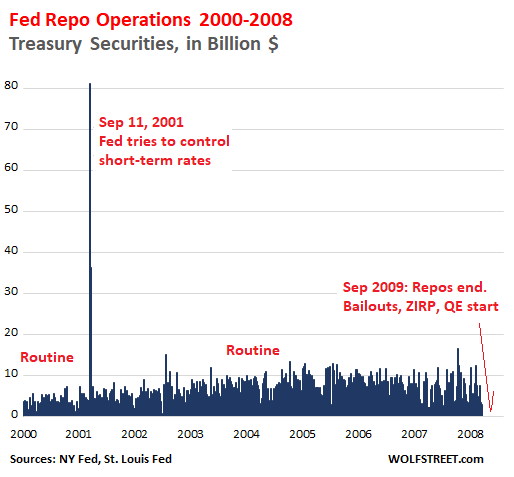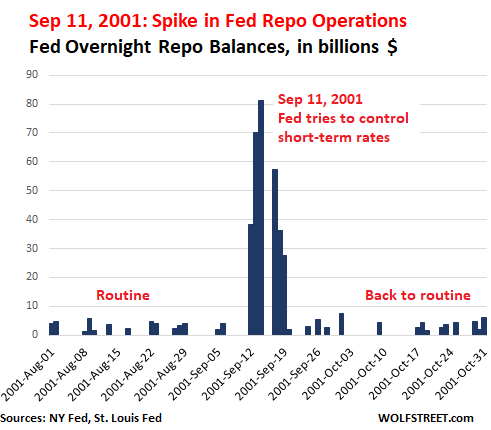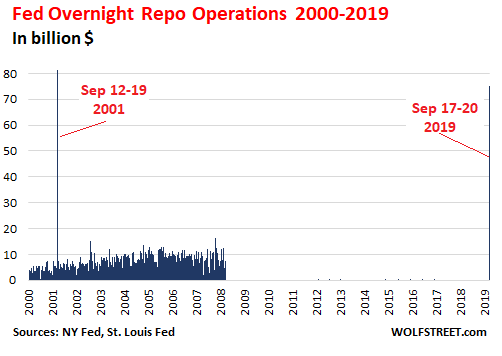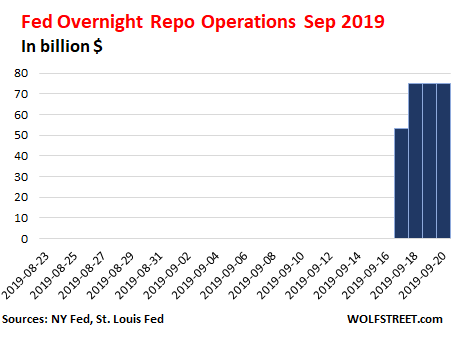Skip to comments.
Fed Admits Failure of ‘Plan A’ to Control Money Market Rates, Shifts Back to Repos ...
WolfStreet.com ^
| 20 September 2019
| Wolf Richter
Posted on 09/20/2019 11:35:56 PM PDT by Yosemitest
Fed Admits Failure of ‘Plan A’ to Control Money Market Rates,
Shifts Back to Repos (which was ‘Plan A’ till 2008)
The hullabaloo in the repo market torpedoed the function of Interest on Excess Reserves and forced the Fed to go back to the future.
With its announcement this morning, the New York Fed confirmed that the Fed’s Plan A of manipulating the federal funds rate into its target range – now between 1.75% and 2.0% — has miserably failed,
and that it will switch to Plan B to control short-term interest rates.
But this Plan B used to be Plan A that the Fed had routinely deployed to control short-term interest rates before the Financial Crisis.
So back to the future.
The “repo operations” the New York Fed has been conducting since Tuesday were overnight repurchase agreements (ultra-short-term loans),
where in the morning, the New York Fed offers up to $75 billion in cash at an interest rate that is within the Fed’s target range.
These loans are secured by collateral.
The allowed collateral are Treasury securities, Agency securities, and mortgage-backed securities guaranteed by the Government Sponsored Enterprises (GSEs).
These are overnight interest-bearing loans unwind the next morning, with the Fed getting its $75 billion in cash back, and the dealers getting their collateral back.
As these operations were undertaken every day for the past four days, it’s essentially the same $75 billion that gets recycled every day.
The daily amounts are not additive.
And these operations have nothing to do with QE.
Back in the day, the New York Fed used to conduct these repo operations routinely.
But in September 2008, when Lehman and AIG collapsed, the Fed switched from repo operations to emergency bailout loans, zero-interest-rate policy (ZIRP), QE, and other tricks and devices.
Repos were no longer needed to control rates.
The chart below shows the tail-end of the era of repo operations through 2008.
The spike in repo operations following September 11, 2001, occurred when the Fed briefly injected massive amounts of cash via repos, as funding had dried up, and short-term rates were blowing out:
During the September 11, 2001 panic, the Fed conducted these massive repo operations for six mornings in a row.
Like all overnight repos, these repos unwound the next day, with the Fed getting its cash back and with banks getting their collateral back.
This chart shows the detail of those operations.
Note the amounts, reaching $81 billion on September 14, 2001.
Four days later, the operations were over, markets had settled down, overnight funding was plentiful, the Fed got its cash back, and the dealers got their collateral back:
In September 2008, when the US financial system was threatening to freeze up, the Fed developed new tools on the spot, including bailout emergency loans to banks, industrial companies, and market players under a variety of programs,
and it shifted to ZIRP and QE.
But it stopped the repo operations because they weren’t needed anymore.
Before the Financial Crisis, there were no Excess Reserves, which are deposits that banks park at the Fed to earn the interest, have instant liquidity, and fulfill regulatory capital and liquidity requirements.
Excess Reserves started piling up in parallel with QE and peaked in December 2014.
Since then, they have fallen by nearly half, to $1.38 trillion.
By paying banks interest on the Excess Reserves (IOER) at a rate equal to the upper limit of its target range, the Fed figured that banks would see to it that the federal funds rate would be less than the IOER.
This would keep the federal funds rate within the Fed’s target range.
This worked until it didn’t.
Throughout 2018, the federal funds rate hobbled along at the upper limit of the Fed’s target range and occasionally exceeded the limit.
The Fed reacted several times by adjusting the IOER to where it was further and further below the upper limit of its target range.
That worked until it didn’t.
And on Monday this week, all heck broke loose in the short-term funding market, which is precisely what the Fed is supposed to be able to keep under control.
On Tuesday, the New York Fed announced its first repo operation since September 2008.
But the magnitude of the financial world has changed over those years: In 2001, the total amount of Treasury debt was $5.6 trillion.
Now it is over four times larger, $22.6 trillion.
Financialization of everything is a booming business,and the bets have gotten larger, the debt has gotten larger, there is more collateral, and so the amounts have gotten much larger.
If peak-repo day on Sep 14, 2001, is multiplied by four, in parallel with the growth of the US Treasury debt, an equivalent overnight repo operation today would amount to $244 billion.
So the $75 billion this morning is small fry.
In the chart below of 19 years of repo operations, the thin line on the right represents the past four days:
Just looking at the repo operations of the last 30 days:
Admission that Plan A failed; Plan B is now standard.
So here is what the New York Fed, which handles the repos, announced this morning “to help maintain the federal funds rate within the target range”:
1. Overnight repo operations will continue through October 10; on Sep 23, for “$75 billion”;
on the remaining days for “at least $75 billion.”
These repos unwind the next day, with the NY Fed getting its cash back and dealers getting their collateral back.
21. Three 14-day repo operations for “at least $30 billion each” (Sep 24, Sep 26, and Sep 27).
Each unwinds after 14 days, with the NY Fed getting its cash back, and dealers getting their collateral back.
3. After October 10, 2019, the NY Fed will conduct repo operations “as necessary to help maintain the federal funds rate in the target range.”
This third point is admission that the repo facility is now once again an integral part of managing short-term interest rates, as it was before September 2008.
The St. Louis Fed already proposed this months ago.
The St. Louis Fed published two papers on the benefits of a “Standing Repo Facility,” This standing repo facility is now in operation, officialized by the New York Fed as of this morning.
The two key – but “distinct” – motivations for a standing repo facility are, as cited in the follow-up paper:
First, the facility could be used to support interest rate control by establishing a ceiling on repo rates, thereby guarding against unwanted spikes in money market rates.
The use of a ceiling tool for this purpose would be seen as enhancing the monetary policy operating regime of the FOMC.
Second, the facility could be used to reduce the demand for reserves for any given rate of interest on excess reserves.
The first motivation is why the NY Fed uses the facility now: to control spikes in money market rates as seen over the past week
and keep the federal funds rate within the Fed’s target range.
The second motivation would be to reduce the excess reserves presumably needed to control the federal funds rate via the IOER.
These reserves and the IOER would become less important, because repo operations now pick up much of the work of controlling money market rates.
And the level of those reserves (currently $1.38 trillion) could be reduced further, allowing the Fed’s balance sheet to shrink further:
Why the desire to minimize the demand for reserves ?
In short, because it accords with the FOMC’s stated preference to operate a floor system with the minimum level of reserves necessary to permit the efficient and effective conduct of monetary policy: “minimally ample reserves” for short.
So this standing repo facility, as we’re looking at it today, takes pressure off those reserves,
and it takes the Fed back a step closer to managing short term rates as it used to do before the Financial Crisis.
Nevertheless, the fact that the Fed was forced all of a sudden by a panicky market to abandon Plan A and revert to how it used to do it, rather than implementing the transition methodically, on its own, in its gradual manner,
must have come as a shock.
TOPICS: Business/Economy; Extended News; Government; News/Current Events
KEYWORDS: bailout; bank; blackswan; debt; deficit; fed; fedrate; inflation; mmt; modernmonetarytheory; moneyprinting; qe; repurchaseagreement
Navigation: use the links below to view more comments.
first previous 1-20, 21-40, 41-60, 61-80 ... 101-120 next last
To: RummyChick
Trump’s problem is that HE HAS NO CONTROL OVER THE FED .
41
posted on
09/21/2019 12:30:42 PM PDT
by
Yosemitest
(It's SIMPLE ! ... Fight, ... or Die !)
To: Moonman62
Yes.
I did.
And I don't trust any of them to tell us the truth.
Why do you think the market took a hit Friday ?
42
posted on
09/21/2019 12:32:28 PM PDT
by
Yosemitest
(It's SIMPLE ! ... Fight, ... or Die !)
To: Georgia Girl 2; Moonman62
“The Fed prints all money out of thin air then lends it to us at interest. All US dollars are debt from inception. “
All of our currency is printed by the Bureau of Printing and Engraving, a branch of the Treasury Dept.
The Federal Reserve purchases bonds owned by commercial banks. This exchanges lendable money for illiquid bonds.
The only interest involved is what is earned on the bond holdings being held by the Federal Reserve. And the vast majority of that goes to the US Treasury. The Fed only gets to keep enough to pay salaries and basic expenses.
43
posted on
09/21/2019 12:34:25 PM PDT
by
Pelham
(Secure Voter ID. Mexico has it, because unlike us they take voting seriously)
To: qaz123
You need an agency to regulate the money supply, and trusting the U.S. Treasury to do that in the face of trillion dollar deficits and $22 trillion is debt is sketchy w/o a gold standard. Having an “independent” agency doing it vs. political appointees at the Treasure Dept. is a better choice. That said I don’t agree with everything the Fed does (2% inflation target, QE, propping up Wall Street instead of Main street, etc, etc).
44
posted on
09/21/2019 12:58:34 PM PDT
by
Drago
To: Toddsterpatriot
It’s a mysterious world to most people who have no real reason to study it. I know that you had a career where the fun world of conspiracy theory wouldn’t survive for a second... maybe as a bond trader... I pay attention to your posts because I can tell that you had real world experience with it. Which naturally makes you a fellow honorary member of the Jekyll Island Secret Society.
My Fed education began in the late 1970s listening to Ed Hart report on the bond market.. the Fed would release money supply data on Thursdays and the Bond Vigilantes would beat the living hell out of bond prices. Not exactly what the Fed was hoping for. Anyone who thinks that the Fed is all powerful certainly wasn’t watching that circus. Anyway that ignited enough curiosity to get me to study the arcane world of money and finance. Ended up getting a Series 7 out of it.
45
posted on
09/21/2019 1:13:13 PM PDT
by
Pelham
(Secure Voter ID. Mexico has it, because unlike us they take voting seriously)
To: Drago
When Nixon broke the link to gold he did it by simple Executive Order... his order actually said that he was just “suspending” gold convertibility rather than ending it permanently... so apparently Trump could counter Nixon’s E.O. with his own E.O. and we’d be back on the Bretton Woods gold standard.
The pressure on the gold standard back then was due to using the dollar as the world’s reserve currency. An economist named Triffin warned as early as 1960 that this wasn’t going to work, either the gold standard or the reserve currency role was going to have to end. Nixon chose to end gold. It would have been wiser to instead replace the dollar with a basket of currencies as the reserve currency.
46
posted on
09/21/2019 1:23:27 PM PDT
by
Pelham
(Secure Voter ID. Mexico has it, because unlike us they take voting seriously)
To: Pelham
I actually asked a very simple question earlier. A simple explanation of what they’re doing with the banks and the $75billion they pumped in. That’s all.
But, right now I read the Fed is pumping billions to help out the banks. Not sure how or if that effects you, me or anyone else.
Is this just another form of Quantitative Easing, which I thought was a very bad thing?
Are you of the ilk that thinks the Fed is a good thing? I’m not.
47
posted on
09/21/2019 1:30:57 PM PDT
by
qaz123
To: qaz123
"Can someone explain, in layman’s terms, what this means and how the Fed seems to be, once again, playing a game ..."
Try this article.
Basically they're devaluing our dollars.
Try watching the link below with the
TRY IT FREE FOR 30 DAYS link, and then go to the link below after you set up your free trial period.
Watch
9/20/19, Easier to Believe in Area 51 Aliens Than the Government , Guest: Bill O’Reilly , "The Glenn Beck Program" ... The banks and the Fed are running out of money,
but since everyone’s thinking with their feelings, a second Great Depression will make Elizabeth Warren look like a DREAM candidate! ...
You can save time by starting at 08:00 into that video and go thru most of the first hour.
After you're finished with that, be sure to go to the "shows" tab and check out "The News and Why It Matters", as well as Mark Levin's Show.
48
posted on
09/21/2019 1:32:32 PM PDT
by
Yosemitest
(It's SIMPLE ! ... Fight, ... or Die !)
To: Pelham
Yep, complicated, gives me a headache...I have yet to find a definitive guide to money supply/currency regulation/reserve bank issues! Any suggestions? Wasn’t sure on “repo” rates either...found this brief description that helped:
“Overnight repo rate is the interest rate at which different market participants swap treasuries for cash to cover short-term cash needs. The repo rate is helping to ensure banks have the liquidity to meet their daily operational needs and maintain sufficient reserves. The repo rate usually trades in line with the Federal Reserve’s target interest rate.” So where did the N.Y. Fed get the $100 billion over the last few days to inject into the repo market? “Printed” $$ ?
https://tradingeconomics.com/united-states/repo-rate
49
posted on
09/21/2019 1:35:08 PM PDT
by
Drago
To: Vigilanteman
I suggest you start buying 1/10 ounce gold coins, or one ounce silver coins or bars.
50
posted on
09/21/2019 1:35:45 PM PDT
by
Yosemitest
(It's SIMPLE ! ... Fight, ... or Die !)
To: OrioleFan
I believe that MANY rich people are trying to start another depression to cause Trump to lose in 2020.
But I also believe that our government has devalued the dollar too many times, and printed too much currency out of thin air, and we're headed for a reckoning, regardless of what those rich and power-hungry elitist are trying to do.
They're just getting our economy to the collapse a lot quicker, than if they weren't trying to collapse it.
And the ILLEGAL ALIEN IN CHIEF didn't help by turning over $150 Billion to the Muslims for those hostages and his selling the USA out with his Nuclear Deal that Trump got us out of.
51
posted on
09/21/2019 1:43:36 PM PDT
by
Yosemitest
(It's SIMPLE ! ... Fight, ... or Die !)
To: jdsteel
To me, it spells disaster.
We should get rid of the Fed, and go back to the "Gold Standard".
52
posted on
09/21/2019 1:46:04 PM PDT
by
Yosemitest
(It's SIMPLE ! ... Fight, ... or Die !)
To: jdsteel
"That’s 10% annualized.
Overnight they got 1/365th of 10% thanks to a short term situation."
WRONG !
It's 10% of the total of the loan for just one night.
53
posted on
09/21/2019 1:48:53 PM PDT
by
Yosemitest
(It's SIMPLE ! ... Fight, ... or Die !)
To: Yosemitest
Wouldn’t gold have to go to $20,000-$30,000/oz. to cover the existing $$ supply under a “gold standard”? I see issues with that.
54
posted on
09/21/2019 1:49:31 PM PDT
by
Drago
To: Yosemitest
WRONG ! It's 10% of the total of the loan for just one night.
LOL!
No.
To: Toddsterpatriot
Nowhere in those articles does it say that the interest is "annualized".
I could be wrong, but I believe the Fed's thinking" is that those interest rates will draw back in some of the worthless dollars they've printed, thus reducing the worthlessness of our dollar.
56
posted on
09/21/2019 2:00:01 PM PDT
by
Yosemitest
(It's SIMPLE ! ... Fight, ... or Die !)
To: Drago
“So where did the N.Y. Fed get the $100 billion over the last few days to inject into the repo market? “Printed” $$ ?”
They “monetize” Treasury debt. Exchange dollar credits for bonds held by banks.
The best way to understand it is to think of Treasury bonds as being part of the money supply. IIRC T-bonds were actually considered part of M3, the broadest measure of the money supply. But bonds are an “illiquid” part of the money supply. They can’t be spent or loaned.
What the Fed can do is convert an illiquid bond held by a bank into liquid money. They take the bond from the bank, and credit the bank with dollars. For a repo this reverses the next day.
So the Fed is actually changing part of the money supply from illiquid to liquid when it does this, rather than adding to the entire money supply.
In contrast, when the Fed sells some of its bond holdings that acts as a sponge, sopping up liquid money and leaving the banks holding illiquid bonds.
This is all part of the Fed’s primary job of trying to keep the amount of liquid money, aka “high powered money”, at a level that encourages economic growth without promoting inflation or asset bubbles.
57
posted on
09/21/2019 2:05:01 PM PDT
by
Pelham
(Secure Voter ID. Mexico has it, because unlike us they take voting seriously)
To: Pelham
OK, then the repo market is a “bank has bond holdings and sells them short term for reserve cash then buys them back in 24 hours” type thing? That I sorta get...but the N.Y. Fed has to get the cash to buy the bonds from somewhere, so sort-term QE I guess? (Money/”M3” “creation/printing”). Also, what is your opinion on the “2% inflation target” shouldn’t it be “0%/stable prices”, or does that mess with the “full employment mandate”? I see 5-6% annual inflation in what I buy when they shoot for a “2%” “core” rate, so that combined with 1%-2% (at best) MM and CD rates as screwing the common “Main Street” man & woman.
Real inflation rates?: http://www.shadowstats.com/alternate_data/inflation-charts
Or do you think Jim W. is way off?
58
posted on
09/21/2019 2:24:54 PM PDT
by
Drago
To: qaz123
“I actually asked a very simple question earlier. A simple explanation of what they’re doing with the banks and the $75 billion they pumped in. That’s all.”
They are providing commercial banks with overnight liquidity that the banks need if you’re speaking of the repos.
“But, right now I read the Fed is pumping billions to help out the banks. Not sure how or if that effects you, me or anyone else.”
The Fed’s job is to keep the banking system functioning by adjusting the money supply.
“Is this just another form of Quantitative Easing, which I thought was a very bad thing?”
Quantitative Easing was done to prevent a recurrence of the massive credit deflation that caused the Great Depression. Bernanke is a student of Milton Friedman and Anna Schwartz, and he took his guidance from their long chapter “The Great Contraction” in their magnum opus “A Monetary History of the United States”
Most who know the history that led to creation of the Federal Reserve see it as a necessary thing, not a good or bad thing.
JP Morgan acted as the defacto central bank and lender of last resort prior to 1913. He had immense political power as well as financial power as a result. Presidents took the train to NYC to ask for his help when there was a financial crisis.
But by the time of the Panic of 1907 Morgan knew that this was not sustainable. The American economy was getting far too big for one private bank to backstop.
Morgan himself pushed Congress to create the National Monetary Commission to study banking and monetary reform. The drive to create the Federal Reserve was due to Morgan. And it served to lessen his power and influence rather than increase it.
“Are you of the ilk that thinks the Fed is a good thing? I’m not.”
So what does your own ilk think should replace the Fed as lender of last resort?
59
posted on
09/21/2019 2:41:20 PM PDT
by
Pelham
(Secure Voter ID. Mexico has it, because unlike us they take voting seriously)
To: Yosemitest
Nowhere in those articles does it say that the interest is "annualized". Because everyone knows it is annualized...…....….
I could be wrong, but I believe the Fed's thinking" is that those interest rates will draw back in some of the worthless dollars they've printed,
Draw back in from where? To where?
Navigation: use the links below to view more comments.
first previous 1-20, 21-40, 41-60, 61-80 ... 101-120 next last
Disclaimer:
Opinions posted on Free Republic are those of the individual
posters and do not necessarily represent the opinion of Free Republic or its
management. All materials posted herein are protected by copyright law and the
exemption for fair use of copyrighted works.
FreeRepublic.com is powered by software copyright 2000-2008 John Robinson



